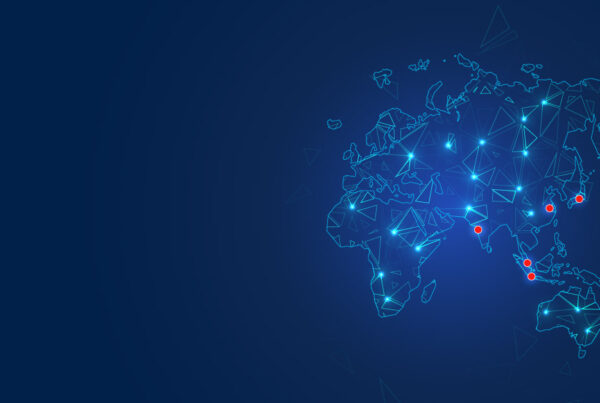Home to more than half of the world’s population, the Asia Pacific (APAC) region has climbed from low- to middle-income status within a single generation, according to the McKinsey Global Institute [1]. Unsurprisingly, sustained growth and rising prosperity are fueling a surging digital economy and accelerating digitalization as businesses seek to leverage a new wave of economic opportunities.
A recent survey of nearly 600 IT respondents found that 43% consider digital transformation as their top priority [2]. And whether these organizations turn to the cloud (36%) or on-premises infrastructure (35%), data center facilities are an inextricable cornerstone of this digital future.
Coupled with factors such as skyrocketing digital media consumption [3] and the proliferation of digital marketplaces [4], it is no surprise why the data center market in APAC is projected by property services consultancy Cushman and Wakefield to overtake North America as early as 2021 [5] and to continue growing at a faster rate.
Pre-empting Human Errors
Of course, breakneck growth in any industry is often associated with shortages of manpower, and the data center market is not immune to this. And while the specifications of a data center and accreditations are typically touted, it is the tireless work of the unseen but competent engineers that keep a facility running – there are few other places where the dearth of skilled manpower is felt more acutely than the data center.
According to an Uptime Institute survey of thousands of professionals in 2019, common IT and infrastructure issues have their roots in mistakes rather than equipment failure. Most respondents (75%) attributed data center failures to human error [6], and said that their most recent significant downtime incident could have been prevented with better processes or system configuration.
As Uptime Institute wrote in a blog in 2019, causes of outages range from a lack of skill from under-investing in training and underestimating the importance of qualified staff, to outdated procedures [7]. This confluence of factors eventually sets off a “cascade of circumstances” that culminates with a dreaded outage. What it means is that, aside from training, the presence of robust operating procedures is just as important when it comes to minimizing human errors.
A Platform for Excellence
At Princeton Digital Group (PDG), we are acutely aware that establishing data centers of the highest caliber and reliability is a combination of technology, people, and process. Having the right systems and skilled professionals in place is a vital starting point for operational excellence, but they must be complemented with automation and robust operating procedures. “By implementing solid business processes improved with automation upgrades along with training programs ensuring our team members are CDCP certified (Certified Data Center Professional), we have been able to maximize our ability to better monitor our 5 data center facilities across multiple locations in Indonesia in real time.”, said Stephanus Tumbelaka, PDG’s Managing Director of Indonesia.
Maintenance and operation should not be people-dependent but rely on standardized, well-documented operational and management procedures enforced across the organization. This is especially true for large data center operators with facilities across multiple locations; the scale of a typical hyperscale facility calls for a different mindset altogether – one with a heavy emphasis on automation and a process-driven methodology.
Putting everything together starts with a simple business plan, which we then support with the judicious use of automation to minimize human error. Our Operations teams are equipped with the latest data center technologies, ensuring that we can always perform process improvement and automation enhancement for our data centers. For instance, we enhanced our Building Automation System (BAS) to integrate all standalone monitoring tools into a single dashboard. With the plan for reporting also taken from the BAS, error-prone manual checklists can also be eliminated.
This transformation process applies to facilities that we acquire, which might be geared towards niche use cases such as telecommunications or serve only internal users. To ensure they meet international standards, we initiate a business process assessment with a gap analysis, making changes such as the transformation of the management service team from solely facilities to connectivity and power systems, and switching from proprietary systems to tools fully owned and operated by us.
With a consistent platform and methodical processes that are kept up-to-date, operational excellence becomes an inevitable outcome rather than a hope. This is a critical feature and a differentiator when it comes to operators that build through acquisition and requires a deliberate effort from the very start to establish a robust platform with a set of minimum standards that each data center within the portfolio must meet.
The PDG Advantage
Though establishing a platform of excellence for a pan-Asia organization with physical infrastructure spread over multiple locations is hardly trivial, it can be achieved by setting up an organization that is also a platform. At PDG, this means not just going broad with executives with the knowledge and experience to manage a regional business but building specific country-level experience that can go deep.
PDG is a developer of internet infrastructure to support the rapid growth of hyperscalers and enterprises across the fastest-growing digital economies in the Asia Pacific. With unmatched experience in establishing and scaling global internet infrastructure, we navigate the complexities of the various markets, opening the door to the growth opportunities our clients seek.
With strategies and standards grounded on global standards and designs, we can deliver consistency in terms of technical skillsets and experience across the leadership team. Finally, our deep local relationships with key partners and supply chains in Asia, as well as knowledge of the intricacies in each country allow us to make it deliver it consistently.
PDG currently operates a comprehensive data center portfolio of more than a dozen data centers in multiple digital economies in Asia such as China, India, Indonesia, and Singapore. We are continuously expanding and will bring news of our expansion efforts to new countries very soon.







